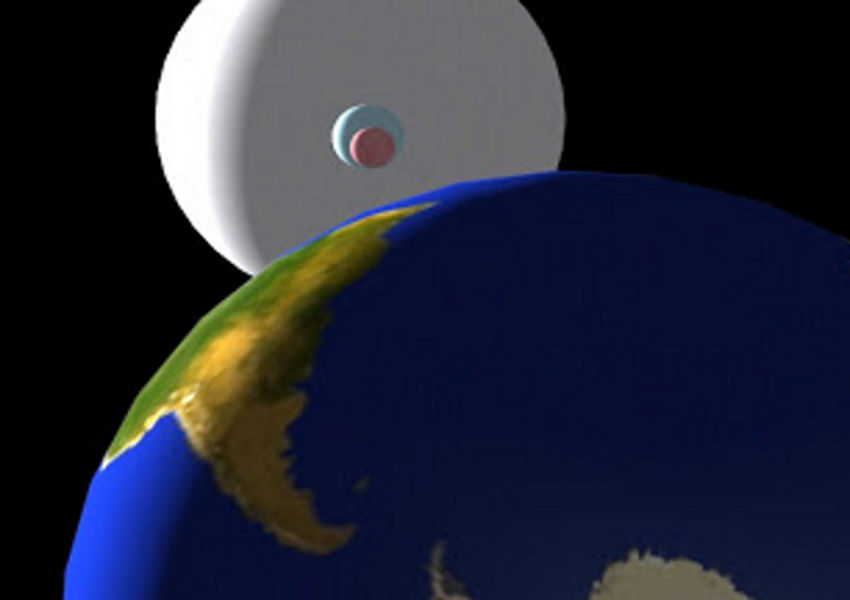
This image spans about 10,000 kilometers. The C-ring, closest to Saturn, is on the left. The B-ring begins just right of center. Cassini’s Ultraviolet Imaging Spectrograph, or UVIS, reveals color variations indicating their composition. Turquoise colored particles are almost pure water ice, while reddish colored ice particles contain other compounds. Credit: NASA/JPL/Space Science Institute.
Sep 18, 2017
Cassini’s data will be analyzed for years to come.
The Cassini spacecraft burned up in Saturn’s atmosphere on Friday, September 16, 2017. Since its original orbital insertion in 2004, it found hurricanes surging through Saturn’s atmosphere, along with lightning storms lasting for years at a time. Most of those observations remain open to further study.
The polar vortices on Saturn are a mystery: both north and south poles are home to spinning vortices on a colossal scale. In the South, a persistent whirlpool of clouds demonstrates electric charge flow from deep inside the planet’s atmosphere, although mission specialists say it is an upwelling of “hot gas”. No mechanism for how the gas is heated, or what force causes convection in Saturn’s frigid outer atmosphere is forthcoming, however. Colder surface gases are said to be drawn down into the warm interior, completing a heat transfer mechanism, as indicated by the “eye” of the southern vortex. Why the rotation is confined to the south pole is not understood, since hurricanes on Earth draw power from warm water as they move across oceans.
In the North, the famous hexagonal formation remains unexplained. Despite winds exceeding 530 kilometers per hour inside the hexagon and 500 kilometers per hour outside, the hexagon does not move except with the planet’s rotation. It was seen by both Voyager probes as they flew by the gas giant in November 1980 and then in August 1981, so it is a long-lived phenomenon. The imaging team does not know how convection can arrange and maintain a six-sided formation in a spinning cloud layer.
Another one of Saturn’s strange features, the ultraviolet auroral light seen at mid-latitudes, baffles scientists studying Cassini’s data logs. It is also accompanied by X-rays glowing from the ring plane and from regions within “Storm Alley”. Since electrons and positive ions cause aurorae on Earth, and always at high latitudes, analysts entered the observation into a “future missions” book, in hopes that more data will provide answers.
The giant white spots that appear in mid-latitudes on Saturn, along with the so-called “dragon storm” that remained fixed in one location since 2004, are puzzling, since they create winds in excess of 1700 kilometers per hour, with continuous lightning 1000 times more powerful than anything on Earth.
Electric Universe advocate, Wal Thornhill wrote:
“Like Jupiter’s Great Red Spot, the dragon storm on Saturn seems to be a long-lived storm center that occasionally flares up. The clock-like regularity of the radio emissions from storms on Saturn is used to judge the great planet’s actual rotation rate beneath the clouds. But this behavior is enigmatic. Why should an electrical storm attach itself to a particular spot on a planet’s surface, particularly when that surface is thought to be liquid?”
The inexplicable hot storms on Saturn, the polar vortices with their (apparently) stable configurations, megalightning, ultraviolet light and X-rays from low latitudes, and winds blowing at a thousand kilometers per hour point to a single cause for all the effects. Add to those observations the “spokes” of the ring system, along with the plasma torus around Saturn, and an electrically active planet is uncovered; part of a circuit connecting the Sun and its plasma sheath, the heliopause.
Radial shadows extending across Saturn’s ring plane, called “spokes”, were first detected by the twin Voyager spacecraft as they flew past the giant planet in November 1980 and then in August 1981. However, when Cassini-Huygens entered orbit around Saturn in July 2004, the spokes were gone. Five years later, the now renamed Cassini-Equinox high resolution imagers saw the spokes, again.
In 2009, another lightning storm lasting more than a terrestrial year was found using Cassini’s Radio and Plasma Wave Science instrument. Radio wave emissions from isolated locations in Storm Alley indicated a reemergence of the Dragon Storm, discussed earlier.
The Electric Universe theory provides a consistent explanation for most of the discoveries that planetary scientists confess are “puzzles” and “due to processes that are poorly understood.” Could there be a connection between the solar cycles, Saturn’s orbital position, the spokes, and lightning discharges? The spokes, for example, are probably caused by radial discharges from Saturn’s magnetosphere into its ionosphere across the ring plane. Since the rings contain a high percentage of ultra-fine dust that is easily ionized, dusty plasma tends to become oppositely charged and move out of, and above, the rings.
Are the spokes an expression of the sunspot cycle? Do they appear at solar maximum and minimum because that is when the magnetic polarity reverses on the Sun and Saturn is at a specific orientation? Further analysis of data from Cassini may improve answers to those questions. Although, it is Saturn’s connection to the electric charge flow in the Solar System that explains most of the effects Cassini discovered.
Stephen Smith
FUTURE SCIENCE: that’s the theme of our sixth annual conference, EU2017. But don’t confuse this theme with science fiction.
Speakers will not be projecting popular ideas and mathematical contrivances into an imagined future. EU2017 will call for science minus the fiction. No Big Bang, no dark matter, no black hole singularities, no neutron stars, no thermonuclear core of the sun, no planets on clockwork orbits for billions of years; few if any “dirty snowball” comets; and no claim whatsoever that comets and asteroids trace to the primitive origins of the solar system (one of the more popular fictions).
This will be an Electric Universe conference, named as such because the electric force is active everywhere across the cosmos. The vastness of space is animated by a life-like sea of charged particles, called plasma, and the plasma universe is the Electric Universe.
For many newcomers to the new paradigm, the greatest discovery will be that the Electric Universe is testable. This is why so many “surprises” of the space age have animated the Electric Universe community, inspiring a global movement. Now we are eager to get the message out, and the EU2017 Conference: Future Science could well be your best opportunity to follow the conversation. Join us and become part of the change.


